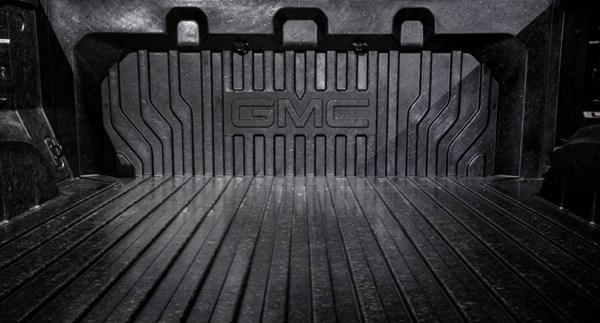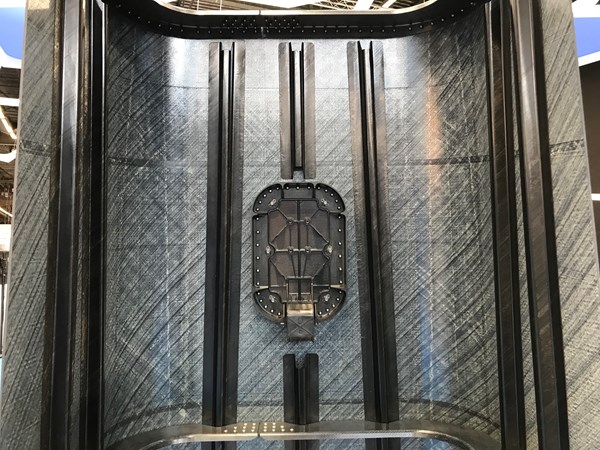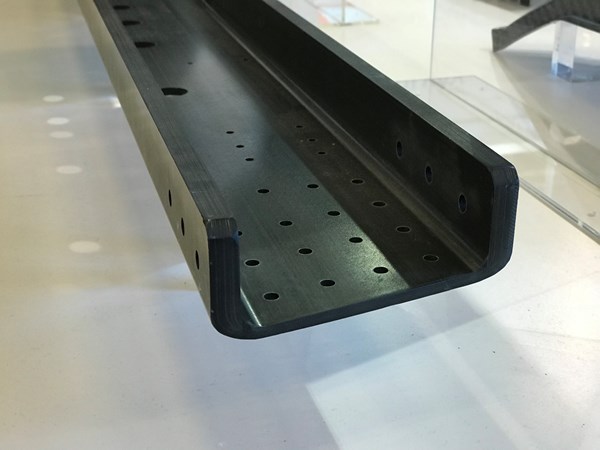Jeff Sloan's top five from JEC World 2018
There is still a third and final day to go at JEC World 2018 in Paris, but there is enough fodder from the first two days of the show to cobble together some thoughts about what we have heard and seen at the show.

2019 GMC Sierra Denali carbon fiber/nylon pickup truck bed.
There is still a third and final day to go at JEC World 2018 in Paris, but there is enough fodder from the first two days of the show to cobble together some thoughts about what we have heard and seen at the show. Without further adieu, here is my top five from the first two days of JEC World 2018.
CSP, GM and a carbon fiber pickup bed. Continental Structural Plastics (CSP) confirmed that is is the manufacturer of the carbon fiber composite pickup bed for the 2019 GMC Sierra Denali. CSP manufactures the beds at its facility in Huntington, IN, US. CSP would not confirm the process used to make the beds, but did confirm that the material is discontinuous carbon fiber and the resin matrix is nylon. It is known, however, that GM and Teijin (which owns CSP) had worked for several years on development of Teijin’s Sereebo process, which features chopped carbon fiber combined with nylon using compression molding. Given this, it is likely the GMC bed is made via Sereebo. The application marks a significant and noteworthy advancement in the application of composites in high-volume automotive manufacturing.
SABIC, Airborne International and Siemens revealed that they have worked together to develop a preconsolidated carbon fiber/polycarbonate laminate product called UDMAX. It’s made in a fully automated process developed by Airborne that orients pre-cut unidirectional carbon fiber tapes in 0° or 90° orientations using plies dropped into conveyorized trays, which pass under drop zones as frequently as desired to build the ply stack. The manufacutring system at Airborne, controlled by Siemens, is expected to go live in early 2019. SABIC will sell laminates.
SABIC/Airborne/Siemens thermoplastic laminate manufacturing line.
Huntsman Advanced Materials reported at JEC 2018 that it has acqired nanomaterials specialist Nanocomp, based in New Hampshire, US. Nanocomp is best know for its Miralon sheet and tape products, fabricated with nonwoven carbon fiber nanotubes. Sheets can be up to 8 ft long and 54 inches wide, and can be slit. Tapes can be up to 1000 ft long. Miralon offers a ver low CTE, high conductivity, high in-plane thermal conductivity and low through-plane themal conductivity. Under Huntsman ownership, said company officials, Miralon production capacity will be gradually increased, as will applications of the material. The Nanocomp name will eventually disapper. Miralon will become a brand within the Huntsman product line.

STELIA Aerospace thermoplastic composite demonstrator fuselage panel.
Partners included Porcher Industries, CETIM/Compose Tool, Sintex NP Group,
Aviacomp and Institut de Soudure.
Planes of tomorrow: Material and equipment suppliers clearly are positioning themselves for the next commercial aircraft programs. Based on several conversations we’ve had at the show, it appears that Boeing will likely officially announce in the next year the development of the 797 (757 replacement), with selection of materials and processes to follow in 2021-2022. After this will come, in the mid-2020s, a possible redesign or clean sheet design of the Boeing 737 and Airbus A320. It is also possible that Boeing will forego the 797 entirely, thereby accelerating redesign of the 737 and A320. Material selection is very much in the air for all of these aircraft. Composites seem like a likely candidate for the wings on all of the planes, and infused carbon fiber thermoset wings seem like a strong candidate. Thermoplastic composites are getting a close look for the fuselage, but capacity and prepreg quality are a concern.

Second source prepreg: Solvay had on its stand a trial carbon fiber/epoxy floor beam developed for the 777X using material it developed. CYCOM EP2150 prepreg will be used by a Mubadala Development Co./Solvay joint venture to fabricate 777X empennage and floor beams. This part and project are notable because Solvay developed CYCOM EP2150 as a functional equivalent of the Toray 3900 prepreg Boeing is using to fabricate the wing skins, wing spar, ribs and wing box for the 777X. Carbon fiber prepregs are, typically, developed to have unique properties, thus it required some effort and time for Solvay to create its own prepreg that so closely matched Toray’s. This would appear to signal to Boeing and Airbus that it is possible, on next-generation commercial aircraft, to have multiple carbon fiber suppliers produce prepreg to a given specification. It remains to be seen if indeed the aircraft OEMs pursue this strategy.
Related Content
COMPINNOV TP2 project promotes use of thermoplastics in aerospace
Completed in 2023, COMPINNOV TP2 explored thermoplastic composites, enhancing the understanding between prepregs and production methods to foster the potential for French aerospace innovation.
Read MoreSyensqo, Teijin Carbon achieve aerospace qualification for composite resin
Resin infusion system Prism EP2400 achieves NCAMP qualification with Teijin Carbon’s advanced NCF and UD reinforcements.
Read MorePrepreg compression molding supports higher-rate propeller manufacturing
To meet increasing UAV market demands, Mejzlik Propellers has added a higher-rate compression molding line to its custom CFRP propeller capabilities.
Read MoreClean Sky 2 outer wing box demonstrator validates OOA LRI, shimless assembly and SHM
Full-scale wing box project achieves TRL 5 with 2% weight reduction and 4% reduction in recurring production costs through improved manufacturing efficiency and assembly processes.
Read MoreRead Next
Scaling up, optimizing the flax fiber composite camper
Greenlander’s Sherpa RV cab, which is largely constructed from flax fiber/bio-epoxy sandwich panels, nears commercial production readiness and next-generation scale-up.
Read MoreNext-gen fan blades: Hybrid twin RTM, printed sensors, laser shock disassembly
MORPHO project demonstrates blade with 20% faster RTM cure cycle, uses AI-based monitoring for improved maintenance/life cycle management and proves laser shock disassembly for recycling.
Read MoreCutting 100 pounds, certification time for the X-59 nose cone
Swift Engineering used HyperX software to remove 100 pounds from 38-foot graphite/epoxy cored nose cone for X-59 supersonic aircraft.
Read More












